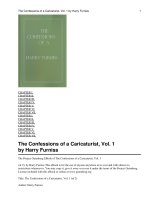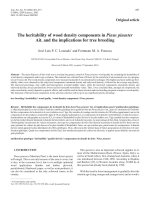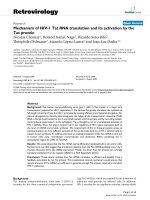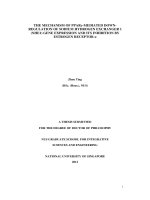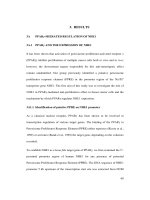THE MECHANISM OF PPARN3 MEDIATED DOWN REGULATION OF SODIUM HYDROGEN EXCHANGER 1 (NHE1) GENE EPXRESSION AND ITS INHIBITION BY ESTROGEN RECEPTOR n1 3
Bạn đang xem bản rút gọn của tài liệu. Xem và tải ngay bản đầy đủ của tài liệu tại đây (8.24 MB, 6 trang )
110
Figure 13: Effects of PPARγ ligands on breast cancer cell morphology and
cell viability.
(A) MCF-7 (3 X10
5
cells/6-well dishes) and MDA-MB-231 (2 X 10
5
cells/6-well
dishes) cells were treated with 15d-PGJ
2,
for 24h, and pictures were taken to show
111
the morphology of the cells. (B) MCF-7 (3 X10
5
cells/6-well dishes) cells were
treated with ciglitazone for 24h before pictures were taken to show the
morphology of the cells. (C) MCF-7 (1.5X10
5
cells/12-well dishes) cells were
treated with 15d-PGJ
2,
for 24h, before crystal violet assay was used to determine
cell viability as described in Materials and Methods. Results denote means +/-SD
computed from two experiments done in duplicate. *, p<0.05, **, p<0.01, treated
versus untreated control.
3A4.2 PPARγ ligands inhibit colony formation by breast cancer cells.
Previous study showed that PPARγ ligands were capable of reducing colony
forming ability of ovarian cancer cells (Vignati et al., 2006). Together with the
data obtained from short-term viability assay, we were stimulated to question if
PPARγ ligands could equally inhibit the cologenic ability of breast cancer cells.
To this end, MCF-7 cells were exposed to 15d-PGJ
2
or ciglitazone for 16h, before
equal number of cells were replated onto 100mm dish and maintained for 14 days.
After crystal violet staining, we observed a dose-dependent reduction in the
number of colonies formed in both cells treated with 15d-PGJ
2
or ciglitazone
(Figure 14A, B). As the colony forming assay is used to detect cells that preserved
progeny-producing ability after drug treatment (Franken et al., 2006), the result
suggests a long-term reproductive inhibition triggered by PPARγ ligands.
To further accertain that the colonogenic inhibition by 15d-PGJ
2
is common in
other PPARγ expressing breast cancer cell lines, MDA-MB-231 and T47D cells
were also subjected to 1µM and 3µM of 15d-PGJ
2
treatment for 16h before the
colony forming assay was performed as described in Materials and Methods.
Similar to what we observed in MCF-7, 15d-PGJ
2
resulted in a dose-dependent
112
reduction in the number as well as the size of the colonies in both breast cancer
cell lines (Figure 14C). It is noteworthy that 15d-PGJ
2
resulted in different extent
of inhibition in the colony-froming ability in all three cell lines. Treatment with
15d-PGJ
2
caused a 95% decrease in the number of colonies formed in MDA-MB-
231 cells, a 83% reduction in MCF-7 cells and only a 36% down-regulation in
T47D cells (Figure 14D). Interesetingly, the extent of inhibition on cologenic
ability of different breast cancer cells mirror-imaged the level of PPARγ receptor
in these cell lines. The three breast cancer cell lines express different endogenous
level of PPARγ receptor. T47D cells that express lowest level of PPARγ showed
the least sensitivity to 15d-PGJ
2
, while 15d-PGJ
2
resulted in the maximal
reduction in the number of colonies formed by MDA-MB-231 cells expressing
the highest level of PPARγ receptor.
113
Figure 14: PPARγ agonists reduce colony-forming ability of breast cancer
cells.
In colony forming assays, MCF-7 (3 X10
5
cells/6-well dishes) cells were exposed
to (A) 15d-PGJ
2
and (B) ciglitazone for 16h before they were washed and
reseeded at a density of 1.0 X10
4
cells/100mm dish. After 14 days of incubation,
cells were stained with crystal violet. (C) MDA-MB-231 (2 X 10
5
cells/6-well
dishes) and T47D (3 X10
5
cells/6-well dishes) cells were treated with 15d-PGJ
2,
for 16h before they were washed and reseeded at a density of 1.0 X 10
4
cells/100mm dish. After 14 days of incubation, cells were stained with crystal
violet. Images of scanned plates are shown. Graphical representation of colony
counts from colony forming assays. Results denote means +/-SD computed from
three experiments. *, p<0.05, **, p<0.01, treated versus untreated control.
114
3A4.3 Anti-tumor effect of 15d-PGJ
2
is PPARγ-dependent.
The correlation between the PPARγ receptor level and the sensitivity to PPARγ
ligands in different breast cancer cell lines strongly implies a regualtory link
between PPARγ activity and its anti-tumor effects. To further cofirm that the
tumoricidal property of 15d-PGJ
2
is a functional consequence of PPARγ activity,
we used the PPARγ inhibitor GW9662. As indicated previously, GW9662
functions as a PPARγ antagonist by modifying the cysteine of PPARγ ligand
binding region and it was effective in blocking the PPRE luciferase reporter
activity induced by 15d-PGJ
2
(Figure 6A). Capitalizing on the antagonistic
property of GW9662, we pre-incubated MCF-7 cells with GW9662 before
exposure to 15d-PGJ
2
. As shown in the long-term conloy forming assay, GW9662
protected the MCF-7 cells from the significant reduction in the number of
colonies formed after treatment with 15d-PGJ
2
(Figure 15A). Based on this
reversal in long-term colongenic ability by PPARγ antagonism and the correlative
data from cells lines expressing varying intrinsic levels of PPARγ receptor, we
concluded that 15d-PGJ
2
induces a PPARγ-dependent anti-tumor effect in breast
cancer cells.
115
Figure 15: PPARγ antagonist rescues the loss of cologenic ability induced by
PPARγ ligand in breast cancer cells.
MCF-7 (3 X10
5
cells/6-well dishes) cells were exposed to 15d-PGJ
2
for 16h with
or without 2h pre-incubation of 10µM GW9662. Following that, cells were


